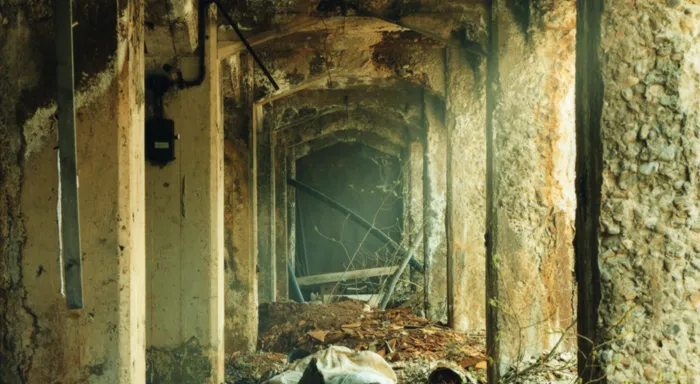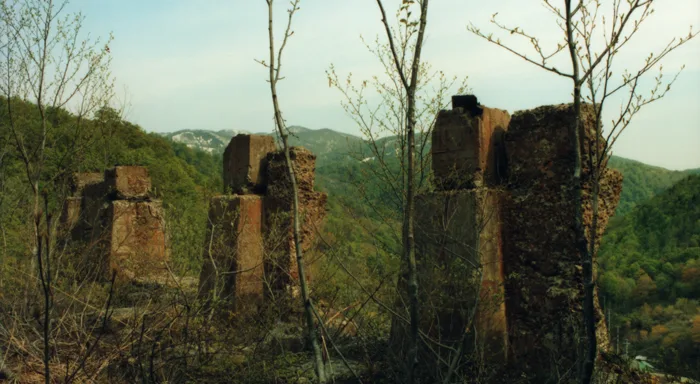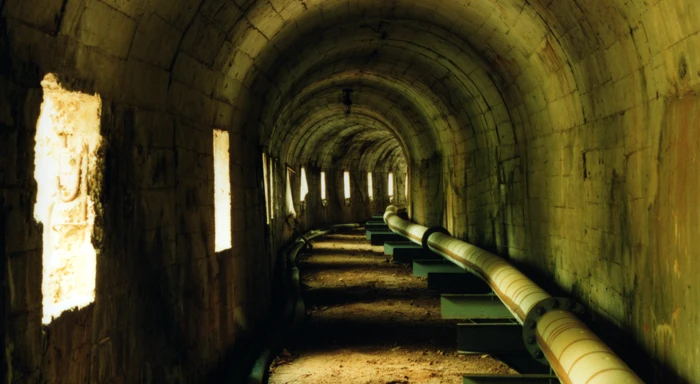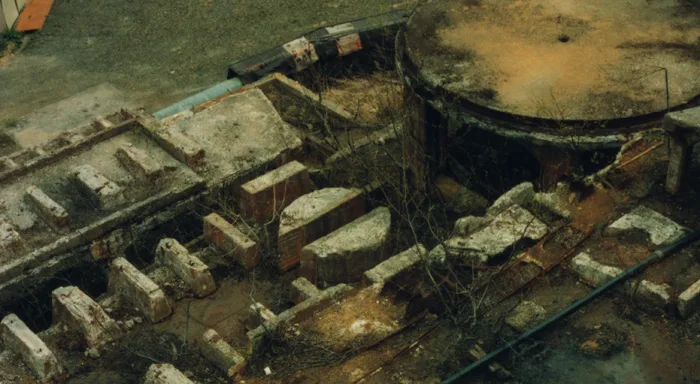上北鉱山跡
県の中央にそびえる八甲田山の北東麓に位置し、胚胎する黒鉱鉱床から銅鉱や硫化鉱を産出して栄えました。
黒鉱鉱床とは海底火山活動に由来する塊状の多金属硫化物鉱床であり、重晶石や黒鉱、硫化鉄鉱、珪鉱などを層状に内包します。
上北は大正初期より複数の事業者によって稼行されますが、本格的な開発は北隣する高森鉱山の経営者 三井栄一による 1935 年(昭和 10 年)の本坑硫化鉱床の発見に始まります。
三井から経営委任を受けた日本鉱業は翌年に鉱業所を設けて開発に着手し、立石と奥之沢に相次いで硫化鉱床を発見しました。
1938 年(昭和 13 年)には野内との間を結ぶ索道と選鉱場を完成させ、二年後に鉱区の譲渡を受けて単独経営による本格操業を開始します。
1941 年(昭和 16 年)に奥之沢において高品位の銅鉱床に着脈すると、翌年に選鉱場を新たに設け、1944 年(昭和 19 年)には 1,400 t を超える国内最大の月産銅量を記録しました。
従業員数は操業当初の 50 名から 1945 年(昭和 20 年)には 1,485 名を数えるまでに拡大します。
戦時中は一部操業の休止を余儀なくされますが、再開後は上之沢に硫化鉱床を、立石に含銅硫化鉱床を発見して生産を回復させました。
その後も選鉱設備の増強を重ね、1956 年(昭和 31 年)に沈殿銅の採取を、翌年に褐鉄鉱の露天採掘を開始して上北は最盛期を迎えます。
後に輸入資源の煽りを受け、1958 年(昭和 33 年)の年間出鉱量 289,742 t を境にして減産に転じますが、堂之沢及び奥之沢での露天採掘を開始して操業を続けました。
生産量の減少に伴い、1971 年(昭和 46 年)に坑内採掘を休止して銅鉱及び重晶石の露天採掘に採鉱を一本化しますが、二年後には休止して閉山を迎えることとなります。
周辺には巨大な選鉱場跡が現在も残ります。
1973 年閉山
Kamikita Mine
The mine is located at the northeastern base of Mt. Hakkoda in the central part of the prefecture and produced copper ore and sulfide ore from black ore deposits.
The deposits are volcanogenic massive sulfide ore deposits comprising stratified barite, black ore, iron sulfide ore, yellow ore, and others.
Several companies mined ore at the mine from the 1910s.
Eiichi Mitsui, a manager of Takamori Mine, discovered a sulfide ore deposit at Honko in 1935 and consigned the management of the mine to Nippon Mining Co., Ltd. in the following year.
Kamikita Mining Works, established by the company, began the development and discovered sulfide ore deposits at Tateishi and Okunosawa later.
The company connected the mine to Nonai by aerial cableway and constructed a beneficiation plant in 1938.
Two years later, the company acquired the mining areas and began full-scale operations independently.
Subsequently, the company discovered a high-grade copper ore deposit at Okunosawa in 1941 and constructed a new beneficiation plant in the following year.
The mine produced over 1,400 tonnes of copper ore per month in 1944, the country's largest at the time.
The number of employees increased from 50 at the beginning to 1,485 in 1945.
Although several operations were paused in wartime, the discoveries of Uenosawa sulfide ore bodies and Tateishi cupriferous sulfide bodies led to an increase in production after the war.
Accordingly, the company repeatedly reinforced equipment of the plants.
Furthermore, the company began the recovery of cement copper in 1956 and produced limonite with opencast mining in the following year.
Thus, the mine reached the peak of its production.
Although production decreased from its peak of 289,742 tonnes of crude ore in 1958 due to the effects of trade liberalization, the company began opencast mining at Doyashiki and Okunosawa later.
The company suspended underground mining operations due to a decrease in production in 1971 and focused on opencast mining operations for copper ore and barite.
Two years later, the operations ceased, and the mine was closed.
The remains of the large beneficiation plant still stand in the mountains.
closure in 1973
Minami-Tenmadate, Shichinohe Town, Kamikita County, Aomori
copper, iron sulfide, iron, zinc, gold, silver, barite

#01
鉱床は性質の異なる塊状または層状の黒鉱鉱床からなり、立石沢に沿って北から立石、本坑、上之沢、奥之沢の 4 鉱床が弧を描くようにして並びます。
The mine had four groups of irregular massive or layered black ore deposits, namely, Tateishi, Honko, Uenosawa, and Okunosawa.
They lined up in an arc from the north along the Tateishi Stream.
View Details

#02
欧米からの軍需資材輸入が途絶えて戦況が劣勢に傾く中、上北は 1944 年(昭和 19 年)に国内最大となる産銅量を記録して神風鉱山と称されました。
In wartime, suspension of the importation of war materials from the West caused the deterioration of the war situation.
However, the mine's copper ore production reached the highest level in the country in 1944 and was referred to as "Kamikaze Mine".
View Details

#03
戦時中は数百人もの朝鮮人労働者やアメリカ人捕虜が過酷な環境下で使役されます。
敗戦後の本国送還に伴い、台湾や朝鮮などからの日本人引揚者が代替労働力として雇用されました。
Hundreds of Korean laborers and American captives were mobilized in poor working conditions during wartime.
After the war, numerous Japanese returned from Taiwan, Korea, and others, employed as replacements for them.
View Details

#04
元山と野内貯鉱舎を結ぶ総延長 21 km の索道は往路に精鉱、復路に資材や生活物資を運搬し、乙供駅から元山までの 28 km の区間はガソリン機関車が人員や重量物の輸送を担いました。
The aerial cableway with a length of 21 kilometers connected the mine to Nonai Ore Storage Facility, transporting material and daily commodities back from Nonai.
Moreover, gasoline locomotives transported personnel and heavy loads for 28 kilometers from Ottomo Station.
View Details

#05
製品は索道によって野内貯鉱舎まで運搬された後、銅精鉱と沈殿銅は日立製錬所、亜鉛精鉱は三日市製錬所、硫化精鉱は東京や大阪、朝鮮の工場へ向けて出荷されました。
The concentrates, transported to Nonai by aerial cableway, were sent to affiliated smelters, namely, copper ore and cement copper to Hitachi Smelter, zinc ore to Mikkaichi Smelter, and sulfur ore to Tokyo, Osaka, and Korea.
View Details

#06
操業開始から数年後、麓を流れる坪川は鉱泥による汚染を受けて魚の生息できない死の川へと変容します。
汚染は流域の水田へ拡がり、鉱害対策が講じられました。
Ore mud contaminated the Tsubo River, flowing at the bottom of the mine, within several years of operation beginning.
The contamination spread to neighboring paddy fields, and measures to prevent mining pollution have been taken.
View Details





